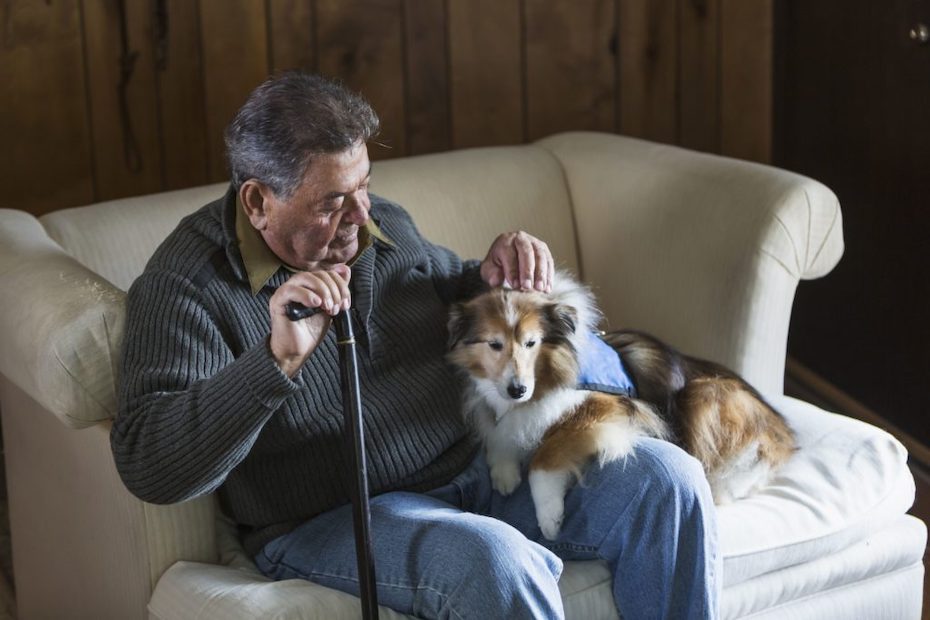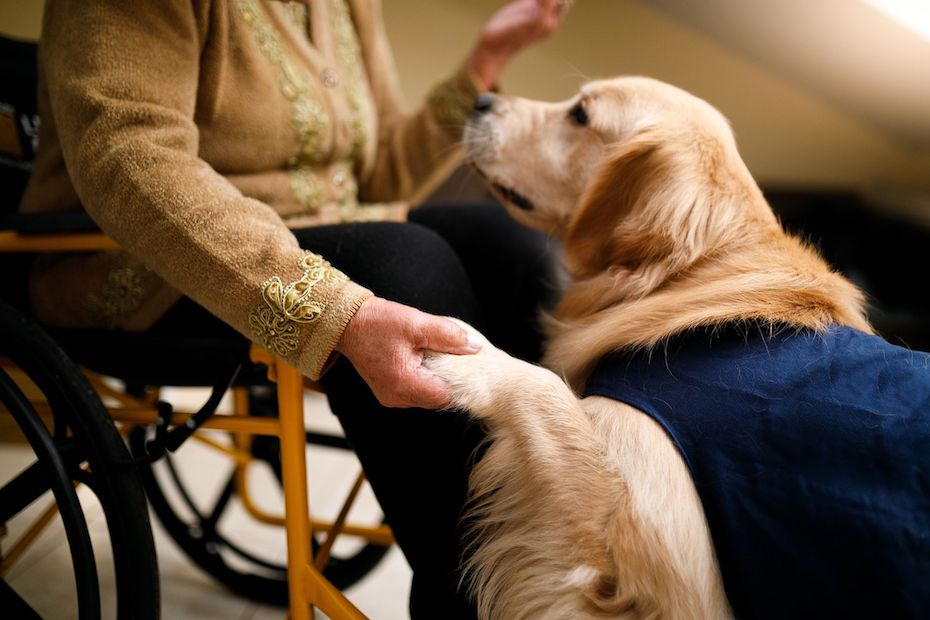Service dogs play a vital role in the lives of people with disabilities, ranging from autism to muscular dystrophy. These loving animals help their owners perform day-to-day tasks, and some are specially trained for people with diabetes, epilepsy, or PTSD. Service dogs play an important practical role in the lives of their partners, but they also become loving friends.
In this blog, we’ll define what a service dog is, review common breeds used, and examine the types of service dogs available. We’ll also review the benefits of service dogs for people with disabilities.
What is a Service Dog?
According to the Americans with Disabilities Act, service dogs are specially trained to perform specific tasks for people with disabilities. These disabilities can be physical, sensory, psychiatric, intellectual, or mental.
Service dogs have full public access rights, which means they can go places where other animals aren’t allowed. This includes restaurants, libraries, and public transportation. There is no universally-accepted list of types of service dogs, but we’ll review some of the most common later in this blog.
Which Breeds Make the Best Service Dogs?
We know that dogs have an outstanding sense of smell that far surpasses humans. In fact, their sense of smell is 10,000 – 100,000 times better than that of people. But it takes more than a good nose to be a service dog. The breeds most commonly used as service dogs share the following key characteristics:
- A desire to work. Your service dog should be happier on a walk or at the dog park than they are laying around at home.
- A calm demeanor. Your service dog can’t cause disturbances in public or be easily startled by their surroundings.
- Intelligence. Your service dog has to perform complex tasks that require innate intelligence and good decision making.
- A friendly disposition. Your service dog must be friendly and comfortable around people and other animals.
- A loving disposition. Your service dog must be able to form a strong bond to best serve your needs.
With that in mind, here are a few of the dog breeds that make the best service dogs:
- Labradors (American and English)
- Golden Retrievers
- German Shepherds
- Poodles
- Boxers
- Great Danes
- Border Collies
- Bernese Mountain Dogs
- Pomeranians
- Portuguese Water Dogs

Types of Service Dogs
There are many types of service dogs out there, and each type offers a host of unique characteristics and benefits. Let’s take a closer look at each type and the benefits of companion dogs for people with disabilities.
Allergy Detection Dogs
These dogs are specially trained to detect and alert to the odor of allergens, such as peanuts, gluten, or eggs. Food allergies are on the rise, and some people go into anaphylactic shock from touching even a tiny amount of an allergen. Allergy detection dogs can pick up the scent of a harmful allergen before their person even comes into contact with it.
Allergy detection dogs are frequently paired with children, since they’re more likely to have severe allergies than adults. This provides kids with more independence and also gives their parents more comfort and security.
Most allergy detection dogs wear vests with pockets for medical information and medication. In many cases, the vest will have a patch directing responders to check their pockets in the event of an emergency.

Autism Service Dogs
Frequently paired with children, autism service dogs are trained to help people navigate social settings. Many people with autism have trouble reading social cues and forming connections with their peers. Dogs make for the perfect icebreaker and can provide a sense of predictability and comfort for people with autism.
Autism support dogs help children connect with their classmates, which can also boost their confidence. Dogs also provide judgement-free love and companionship, which can help people with autism improve their communication skills and keep their emotions under control.
Autism service dogs are trained to keep children with autism from running away and can also track them if they do run off. They can also interrupt harmful behavior or alert the parents of a child with autism to a potentially dangerous situation. If their partner is young and/or non-verbal, autism service dogs should carry emergency protocols and contact information.
Diabetic Alert Dogs
These service dogs are specifically trained to alert their person to potentially-deadly blood sugar highs (hyperglycemia) and lows (hypoglycemia). When the dog alerts, the partner knows to test their blood and then inject insulin or ingest glucose to adjust their levels. Like other service dogs, diabetic alert dogs provide their owners with a heightened sense of independence and security.
Diabetic alert dogs are typically also trained to alert other people in the household or set off an alarm if their person needs medical assistance. Some dogs are even trained to call 911 on a special K-9 alert phone if they’re home alone. These dogs should also carry emergency protocols in their vests so first responders know how to proceed.
Guide Dogs
Perhaps the most commonly-known type of service dogs, guide dogs help blind and low-vision individuals navigate the world. These dogs typically wear a special harness with a handle for their owner to grasp, rather than a vest.
Unlike other service dogs, guide dogs practice what’s called selective disobedience. This means they obey commands, but still make choices based on their own assessment of a situation. For example, their partner may command them to cross the street, but the dog will disobey if there are cars coming.
Labradors, golden retrievers, and German shepherds are commonly trained as guide dogs. If partners have an allergy, they might opt for a labradoodle or a poodle, both of which are hypoallergenic.
Hearing Dogs
Like their name suggests, hearing dogs are trained to assist their deaf and hard-of-hearing partners. When the dog hears a particular cue, they alert their owner and lead them towards the noise. These cues include smoke or fire alarms, doorbells, door knocking, phones, alarm clocks, and even the person’s name.
Like other support dogs, hearing dogs increase their partners’ independence and awareness, both in and out of the home. Common breeds used include labradors, golden retrievers, cocker spaniels, and poodles (miniature or standard). While they aren’t required to wear special gear, some owners outfit their hearing dogs in bright orange.

Mobility Assistance Dogs
Many people with disabilities rely on mobility assistance dogs to help them perform everyday tasks. This includes retrieving objects, opening doors, pressing automatic door buttons, and turning on lights. Mobility support dogs are typically partnered with people who have things like:
- Spinal cord injuries
- Brain injuries
- Muscular dystrophy
- Arthritis
- Cerebral palsy
Some mobility assistance dogs are specifically trained to brace partners with balance issues. Bracing dogs must be large enough to support their person and are typically 55-plus pounds. They often wear specially-fitted harnesses that help them assist their owner.
Additionally, some mobility assistance dogs specialize in helping owners in wheelchairs. They can retrieve objects, open doors, and help with transfers to chairs, beds, or bathtubs. They may wear a special harness that allows them to help pull their owner’s wheelchair.
Psychiatric Service Dogs
These companion dogs are specifically trained to help individuals who suffer from things like depression, anxiety, and post-traumatic stress disorder (PTSD). They’re able to sense a change in their owner when they’re about to experience negative symptoms, such as an anxiety attack or a flashback.
There are many benefits of service dogs for anxiety, depression, and PTSD. Owning a service dog can force people with depression and/or anxiety to take care of themselves and get out into the world.
There are also benefits of service dogs for veterans, who often suffer from PTSD. Psychiatric service dogs can serve as a physical barrier between their owner and other people, helping to preserve their personal space. Support dogs can also help their partners feel more confidence when entering their home. Psychiatric service dogs are the main type of service dog for PTSD.
It’s important to remember that psychiatric service dogs are different than emotional support dogs or therapy dogs. Like other service dogs, they go through extensive training and aren’t considered pets under the legal definition.
Seizure Alert Dogs
These service dogs assist individuals before, during, and after a seizure. This includes:
- Finding help for their person or calling 911 with a K-9 alert phone.
- Helping their partner regain consciousness after a seizure.
- Physically moving their person if they have a seizure in an unsafe place.
- Using deep pressure stimulation to end their partner’s seizure early.
- Bringing medicine to their person as they come out of a seizure.
Scientists and medical professionals are divided over whether seizure alert dogs can be trained. Some people believe dogs can be trained to alert for seizures. However, others believe it’s something a dog does naturally based on intuition and the bond with its human partner.